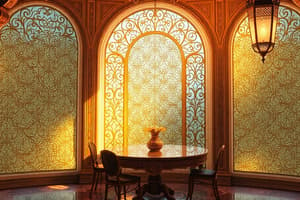Podcast
Questions and Answers
What factor determines the reflectivity of a mirror?
What factor determines the reflectivity of a mirror?
- The color of the mirror
- The angle of reflection
- The thickness of the mirror
- The material used and the wavelength of light (correct)
What is the relationship between the angle of reflection and the angle of incidence?
What is the relationship between the angle of reflection and the angle of incidence?
- They are unrelated
- They are always equal (correct)
- They are always parallel
- They are always perpendicular
Which type of mirror is highly reflective for visible light but less reflective for infrared and ultraviolet wavelengths?
Which type of mirror is highly reflective for visible light but less reflective for infrared and ultraviolet wavelengths?
- Plane mirror (correct)
- Convex mirror
- Spherical mirror
- Concave mirror
What is the major utility of mirrors in scientific exploration?
What is the major utility of mirrors in scientific exploration?
Why are mirrors considered indispensable in tasks such as personal grooming?
Why are mirrors considered indispensable in tasks such as personal grooming?
What is the principle by which mirrors work?
What is the principle by which mirrors work?
Which type of mirror is commonly used in everyday applications like bathroom mirrors?
Which type of mirror is commonly used in everyday applications like bathroom mirrors?
What type of mirror is designed to focus light to a point?
What type of mirror is designed to focus light to a point?
What is the fraction of incident light that is reflected called?
What is the fraction of incident light that is reflected called?
In what medium does light travel slower, causing it to reflect off a smooth surface?
In what medium does light travel slower, causing it to reflect off a smooth surface?
What is the ideal reflectivity percentage of a perfect mirror?
What is the ideal reflectivity percentage of a perfect mirror?
Flashcards are hidden until you start studying
Study Notes
Reflective surfaces like mirrors play a significant role in our daily lives, from personal grooming to scientific applications. They are essential components of various devices such as telescopes, cameras, and imaging systems. This article delves into the world of mirrors, covering their basic principles, types, properties, and uses.
Reflection of Light
Mirrors work by reflecting light using a smooth, reflective surface. Light traveling in a medium with a higher index of refraction, such as water or glass, is slowed down. When light encounters a smooth, reflective surface like a mirror, it is reflected at a glancing angle, bouncing off the surface without entering it.
Types of Mirrors
Plain Mirrors
The simplest type of mirror is a polished, flat surface, typically made of glass or a similar reflective material. These mirrors do not have any curvature and are often used in everyday applications, such as bathroom mirrors or for taking selfies.
Spherical Mirrors
Spherical mirrors are curved mirrors that are either convex (bulging out) or concave (curving inwards). Their curved surface focuses light to a point, making them useful for magnification and focus.
Properties of Mirrors
Reflectivity
The reflectivity of a mirror, also known as its reflectance, is the fraction of incident light that is reflected. In ideal conditions, a perfect mirror would have a reflectivity of 100%, meaning it would not let any light pass through.
Reflectivity Range
In reality, no mirror is 100% reflective. Reflectivity depends on the material used, and it varies with the wavelength of light. For example, gold is highly reflective for visible light but less reflective for infrared and ultraviolet wavelengths.
Reflection Angle
The angle of reflection is the angle between the incoming light ray and the mirror's surface. It is equal to the angle of incidence, meaning the reflected ray will have the same angle with the normal (perpendicular) to the mirror surface.
In conclusion, mirrors are integral parts of both everyday life and advanced technology. Their ability to reflect light makes them indispensable for tasks ranging from personal grooming to scientific exploration. Understanding the properties and uses of different types of mirrors helps us appreciate their versatility and utility.
Studying That Suits You
Use AI to generate personalized quizzes and flashcards to suit your learning preferences.




